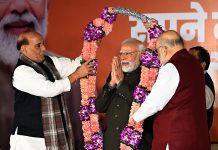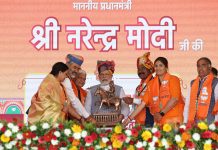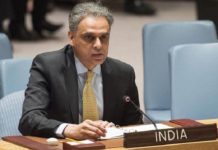 With its electoral victory in Tripura and formation of governments in Nagaland and Meghalaya in alliance with local parties, the BJP has put six out of eight states of North-East India in its kitty. Put together the BJP is now in power, either directly or through an alliance, in 21 out of India’s 29 states. Party president Amit Shah, recently said, “We have an MP in Ladhakh and Kerala. We have a government in Kohima and in Kutch”. Influence of the BJP, which was once confined to the so-called cow belt or Hindi-speaking states, is now, in Prof. Rajni Kothari’s words ‘a dominant party’ in every region of the country, barring the deep south and a portion of the east. Within a short span of less than four years, the saffron surge is prominently visible everywhere.
With its electoral victory in Tripura and formation of governments in Nagaland and Meghalaya in alliance with local parties, the BJP has put six out of eight states of North-East India in its kitty. Put together the BJP is now in power, either directly or through an alliance, in 21 out of India’s 29 states. Party president Amit Shah, recently said, “We have an MP in Ladhakh and Kerala. We have a government in Kohima and in Kutch”. Influence of the BJP, which was once confined to the so-called cow belt or Hindi-speaking states, is now, in Prof. Rajni Kothari’s words ‘a dominant party’ in every region of the country, barring the deep south and a portion of the east. Within a short span of less than four years, the saffron surge is prominently visible everywhere.
The Saffron Surge
Sources within the BJP rank the party’s recent victory in the North-East as its most significant electoral story since it won the 2014 Parliamentary elections. Some political observers opine that most of BJP’s electoral gains in the North-East region had started manifesting in 2016 when the party won Assam for the first time in 2016 and Manipur for the first time in 2017 and in Arunachal Pradesh where the BJP came to power in 2016 by engineering a large defection from the Congress. With regard to significance of the BJP’s electoral victory in the North-East, some experts give credence to party president Amit Shah’s interview to a national daily in early January this year where he had said that his party was expected to win more Lok Sabha seats in the North-East than it had in 2014, when it had won 10. These experts further opine that it would perhaps help the BJP offset some of the losses it is bound to suffer in the Hindi belt (Uttar Pradesh, Gujarat, Rajasthan and Madhya Pradesh) where it won 149 seats out of a total of 160 the last time.
The electoral victory in the North-East assumes special significance for the BJP because it comes against the run of play in recent months when the party returned to power in Gujarat but with a significantly reduced majority in terms of seats while retaining its vote share and lost by-elections to two Lok Sabha seats in Rajasthan. The BJP has pinned high hopes on Karnataka (where elections are due soon) and Rajasthan and Madhya Pradesh, where elections will be held towards the end of 2018. Going by the tone and tenor of BJP’s government formations in the North-Eastern states, some experts call it Congress-isation of the BJP because from Arunachal Pradesh to Manipur, and now in Meghalaya and Nagaland, the BJP has used the opportunist’s rulebook for somehow getting into the driver’s seat.
While pointing out inability of the BJP to cobble a joint declaration with its alliance partner in Tripura, many experts also opine that the party played both sides of the fence in Nagaland and then picked up the one with the higher number of legislators and in Meghalaya, with just two seats to boast of, it played the kingmaker with its bag of tricks and opportunistic stabling with parties aggressively seeking the redrawing of boundaries with neighbouring states, also controlled by the BJP. Cautioning that an unscrupulous approach to power will complicate governance in the North-East, experts also warn that the BJP will have to grapple with pressing sub-local concerns, such as influx of contiguous tribes, overlapping claims for land, balancing the aspirations of identity and development among indigenous tribal and non-tribal population. These experts also bemoan the fact that rather than a healthy, incorruptible and forward-looking alternative, the BJP has cast itself in the same mould as its bête noire, the Congress.
Third Front
The BJP’s juggernaut of electoral triumph has spurred many regional satraps to call for the formation of a Third Front – an alliance of non-BJP and non-Congress parties. Such an idea is already floating in Karnataka where JD (S), BSP, NCP and the Left parties are contemplating in this regard and the latest to give such a call is Telangana Chief Minister K Chandrasekhar Rao (KCR), who is reportedly seeking to give the 2019 Assembly elections in Telangana a national perspective.
According to media reports, KCR is anxious to usher in “qualitative change in the country’s politics” by calling for a non-Congress, non-BJP platform entailing TRS, TDP, YSRCP, DMK and Kamal Haasan’s fledgling party in Tamil Nadu, the Left in Kerala, and possibly JD(S) in Karnataka. While averring that KCR has revived the idea of a coalition led by southern regional parties to halt the BJP’s ingress into the south, some political observers say KCR appears to be working on the assumption that anti-incumbency in many BJP-ruled states will not fetch it an absolute majority in 2019, so a Third Front would be in a position to form the government at the Centre. While recalling the role of TDP founder late N T Rama Rao in stitching together such a front, called the National Front, in 1989, one analyst says that the rise of BJP in the North-East has forced regional party leaders like KCR to plan a strategy to counter the BJP in their states.
Many political analysts feel that the so-called Third Front comprising regional satraps from the South cannot stop BJP’s political juggernaut in 2019 and coming together of regional parties from the Hindi-speaking states is indispensable. The recent bonhomie between the Bahujan Samaj Party (BSP) and the Samajwadi Party (SP) for the parliamentary by-elections for Gorakhpur and Phulpur seats held on March 11 is a good beginning if it succeeds. The Congress offer of support was spurned by the Samajwadi Party. Ensuing assembly polls in Karnataka will also be a litmus test for the viability of the Third Front.
Congress’ Conundrum
Startling continuous fall in electoral fortunes of the Congress is attributable to a vast array of factors like disconnect with the masses, organizational weakness, paucity of fiscal resources, mass desertion of regional level leaders to the BJP, etc. According to one opinion, being in the Opposition at the Centre makes the Congress less attractive for local political elites. Some experts point out inability of the Congress high command to revitalize the party in states where it is not in power. It invested its energy in Gujarat and managed to reap good dividends and now it is concentrating its focus on Karnataka and hopes to fare better. It should have invested similar energy in the North-East as well.
The second problem confronting
The Congress is the level of factionalism in each state unit. Factionalism, internal fissures and bickering at the state unit level leads to draining out a lot of energy and sinking of party morale which belies the hope of a coherent, unified party ready for battle. One expert has opined that the Congress High Command has been unable to stem the tide of desertions at the state level in the absence of personal investment in wooing and retaining leaders as well as sustaining the morale of the cadre.
Some experts have aptly summed up weaknesses of the Congress in these words: “The Congress is at a complete loss in terms of a narrative and message. When it is a challenger, it is not aggressive enough. When it is an incumbent, it is not able to defend its record. It has lost the art of stitching together multi-ethnic alliances, so critical to political success… It has lost the skill of saying different things to different constituencies yet being able to take them all together. It is not seen as standing for either development or identity rights.” These experts further warn that unless the party leadership decides that each state is significant, “unless state leaders work in tandem and factional battles are resolved, unless incentives change and the desertions stop, unless the Congress realises that getting up late is no longer an option in elections, and unless it figures out its own story, its revival in the region will be difficult.”
Way Ahead
Under the given circumstances, Congress of its own is unable to stop Modi’s political juggernaut. While setting its own house in order, the Congress needs to make itself acceptable to other non-NDA parties. Admittedly, it is only an alliance of like-minded democratic Opposition parties, which can challenge and replace the present political dispensation. Regrettably, the major regional and sub-regional parties are either intellectually or politically not convinced on the need to form an alliance to replace the present ruling dispensation at the Centre and they are more interested in floating regional arrangements for their own convenience at the expense of national interest.
The Bihar Model of ‘Mahgathbandhan’ had raised some hopes of taking on BJP’s political juggernaut, but it also fell a prey to political opportunism guided by narrow and petty political interests. Even after humiliating electoral drubbings, many regional parties have not risen above narrow interests. Anti-BJP stance is understandable and can be good incentive spurring Opposition unity, but anti-Congress stance at a time when the Congress itself is faced with existential crisis by these regional parties and the Left is puzzling.
letters@tehelka.com













